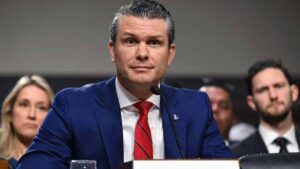Trump’s Stunning Accusation Backfires as Fans Expose His Alleged Use of Fake Crowd Images at Rally

Photo: Mandel Ngan/AFP/Getty Images
According to a report by Mail Online on Monday, August 19, 2024, former President Donald Trump finds himself at the center of a controversy surrounding the authenticity of crowd images from his own campaign rallies, just days after falsely accusing Vice President Kamala Harris of using artificial intelligence to fabricate attendance at her recent event in Detroit.
Trump’s baseless claims about Harris’ rally quickly unraveled as numerous photographs, videos, and eyewitness accounts from journalists and attendees confirmed the presence of a substantial crowd estimated at 15,000 people by the Harris campaign and local media outlets.
The Republican presidential nominee’s fixation on crowd sizes has been a recurring theme throughout his political career, often leading him to exaggerate attendance figures and disparage his opponents’ ability to attract supporters.
However, in a stunning reversal, Trump’s own supporters have now come forward with allegations that the former president’s campaign has relied on manipulated images to inflate the appearance of crowd sizes at his rallies.
Social media users claiming to be Trump fans have shared side-by-side comparisons of images from recent Trump events, pointing out inconsistencies and anomalies that suggest the use of digital manipulation techniques to clone, duplicate, or generate artificial crowd elements.
One particularly damning example shows an image from a Trump rally in Phoenix, Arizona, where a section of the crowd appears to have been copied and pasted multiple times, creating a repeating pattern of identical faces and clothing.
Another image, purportedly from a Trump event in Missoula, Montana, has come under scrutiny for the presence of seemingly artificial crowd elements that lack the natural variation and detail expected in a genuine photograph.
Trump’s campaign has vehemently denied these accusations, dismissing them as a “desperate attempt by the fake news media” to undermine the former president’s popularity and momentum in the 2024 race.
However, the allegations have gained traction on social media, with many users expressing a sense of betrayal and disillusionment over the possibility that their admiration for Trump’s ability to draw massive crowds may have been based on deception.
Digital forensics experts have begun analyzing the questioned images, employing advanced techniques such as metadata analysis, error level analysis, and AI detection algorithms to determine the likelihood of manipulation.
While the investigations are ongoing, the controversy has already dealt a significant blow to Trump’s credibility, as he faces mounting criticism for his history of spreading misinformation and engaging in baseless attacks on his political rivals.
The irony of the situation has not been lost on Harris’ campaign, which has responded with a mix of humor and exasperation, urging Trump to focus on substantive issues rather than obsessing over crowd sizes and peddling conspiracy theories.
As the 2024 presidential race heats up, the controversy surrounding Trump’s alleged use of fake crowd images serves as a cautionary tale about the dangers of political deception and the importance of fact-checking in an era of digital manipulation.
With trust in political figures already at a low point, the revelations have the potential to further erode public confidence in the democratic process and underscore the need for greater transparency and accountability from candidates and their campaigns.
As the nation grapples with the implications of this latest scandal, it remains to be seen how Trump will navigate the fallout and whether his supporters will continue to stand by him in the face of mounting evidence of deception and hypocrisy.
One thing is certain: the 2024 presidential election will be a test not only of the candidates’ policies and vision for the country but also of the American people’s ability to discern truth from fiction in an increasingly complex and manipulated media landscape.





